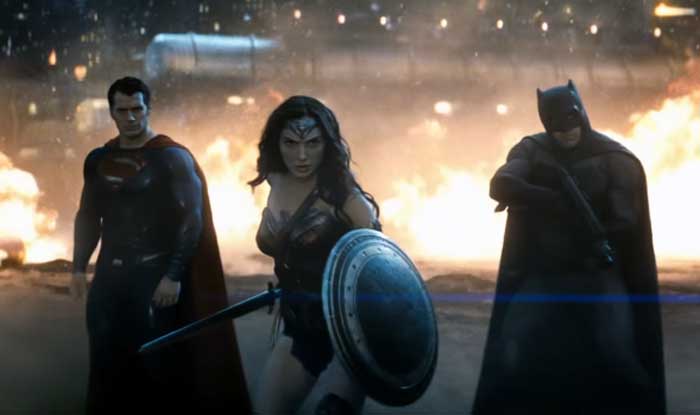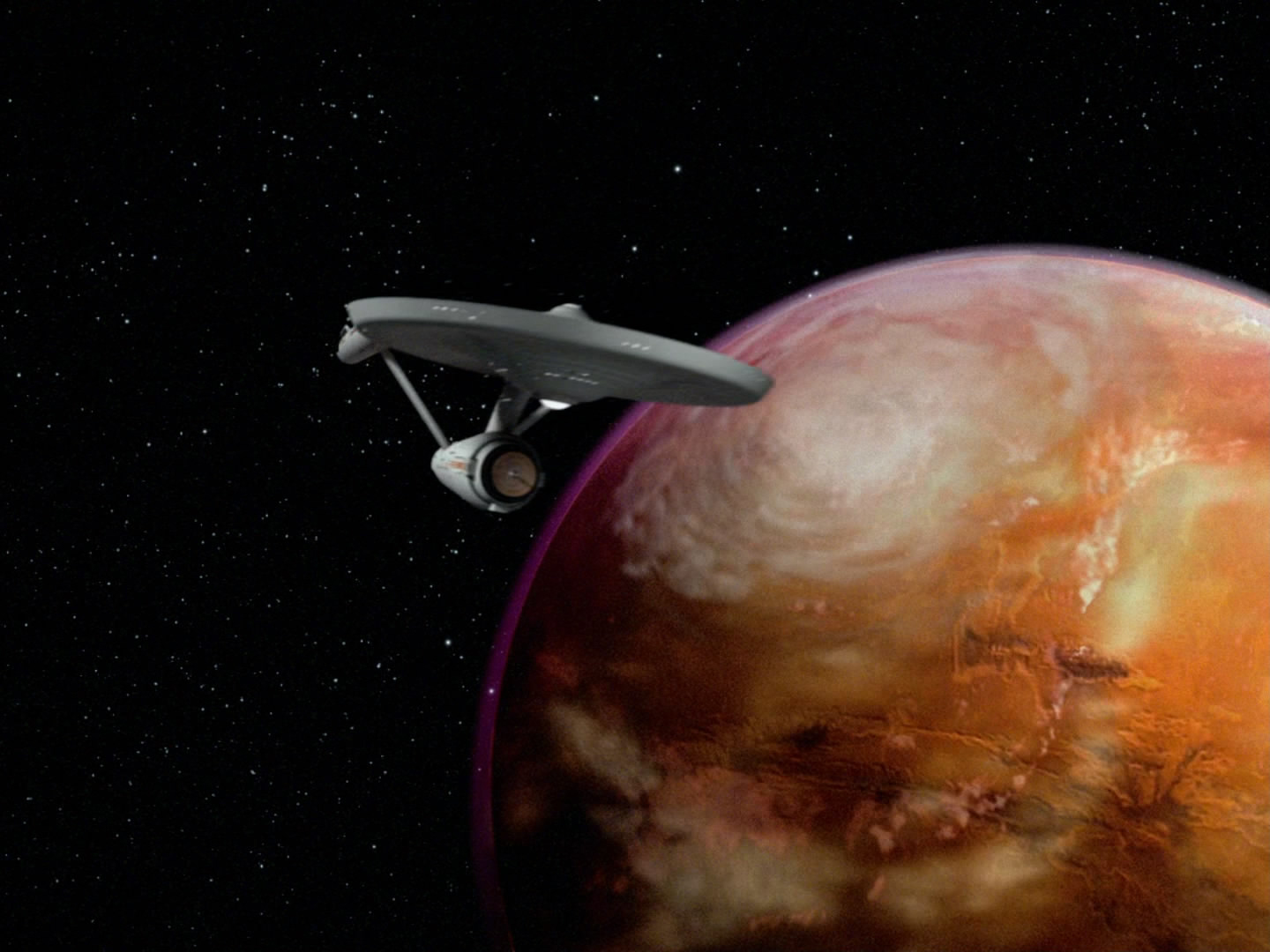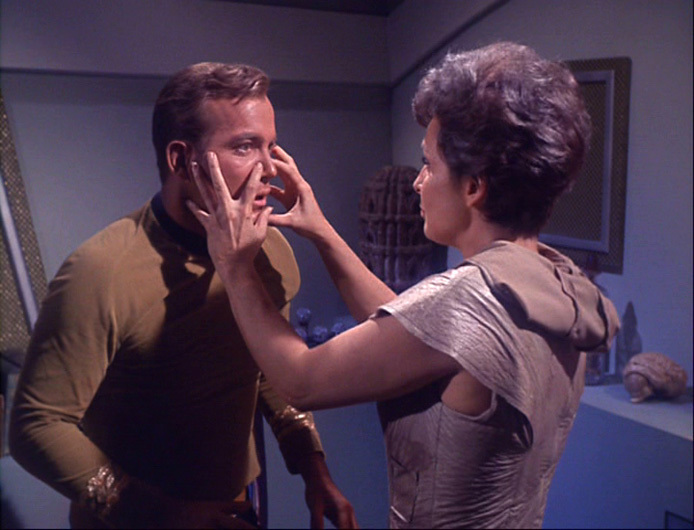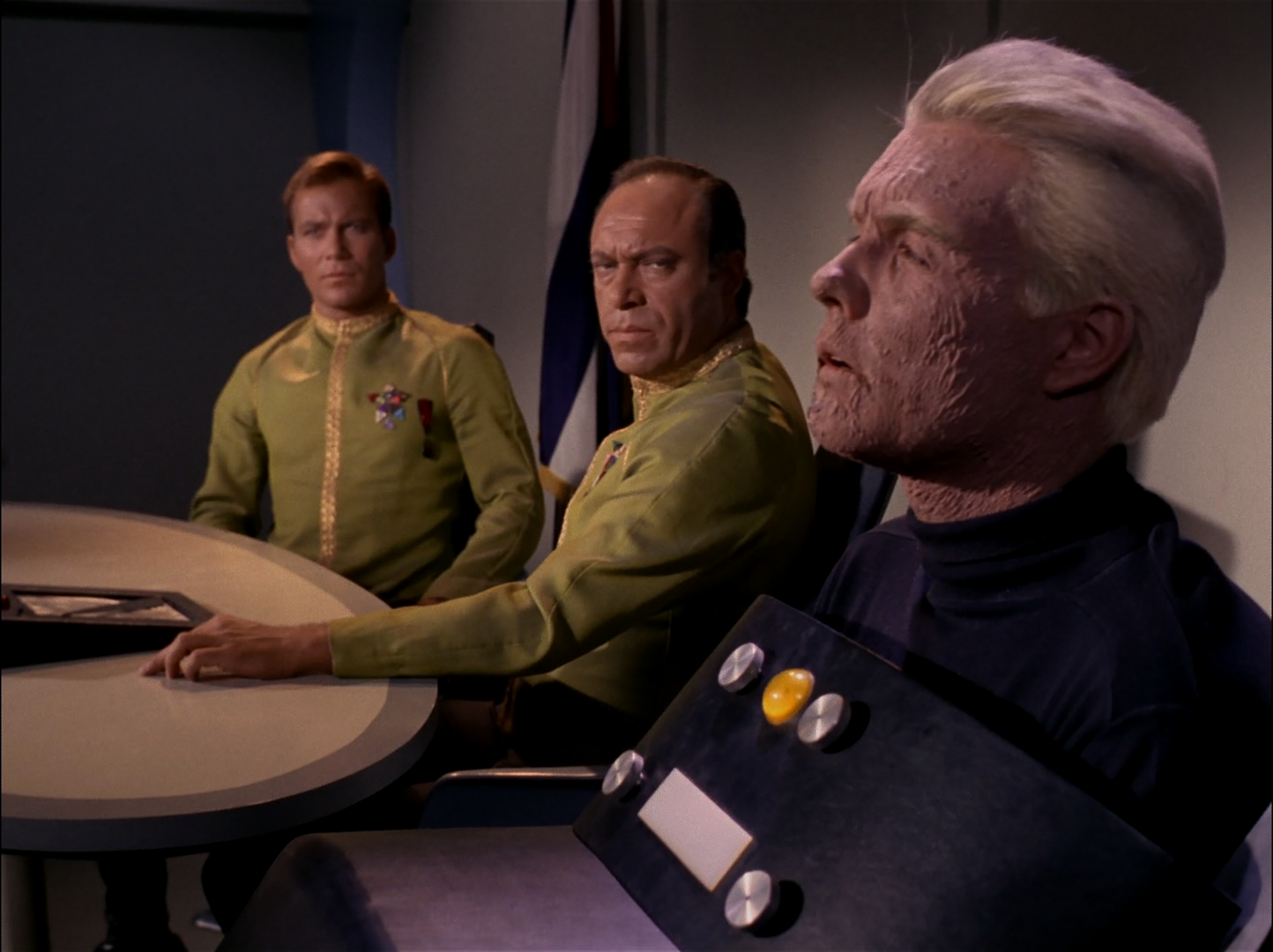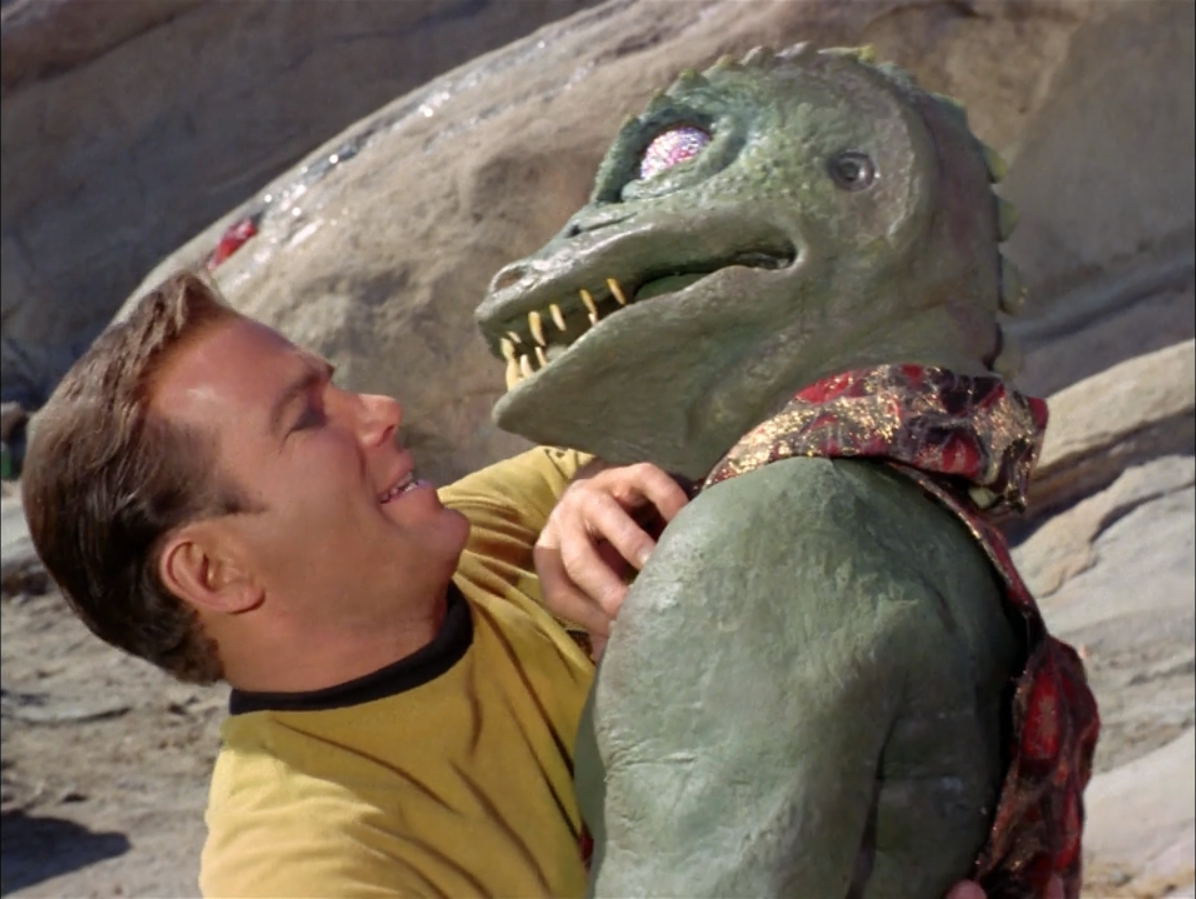
As the second annual ‘Trek Week’ continues here on Rhode
Island Movie Corner, I’ll be doing something a little bit different today;
something sort of along the lines of a ‘thesis’ as I work to defend two of my
favorite films of the last few years; J.J. Abrams’ Star Trek films. Despite what some fans may claim, these two films
are very important to the franchise as they very much resurrected it after
almost half a decade of no new major Star
Trek media. And they’re also very important to me as not only are they some
of my all-time favorite films (the 2009 Star
Trek film is legitimately in my Top 10 favorite films of all-time) but they
also helped me get into the Star Trek franchise
in the first place, and the same can be said for other people who went into it
not being very familiar with the franchise. However, when it comes to long-time
fans of Trek, these films aren’t
really as liked. In fact, they’re pretty much hated by them for various reasons
and said backlash got even more vocal when the 2013 sequel, Star Trek Into Darkness, was released.
Simply put, the big argument amongst this crowd is that the films ‘don’t carry
the feel of the franchise’. As a result, there’s now a lot of pressure on
director Justin Lin and writers Simon Pegg and Doug Jung to make sure that the
upcoming Star Trek Beyond does a
better job at appealing to the long-time fans. And I won’t lie… all of this
backlash kind of frustrates me. Because I am not embarrassed to admit that I am
a major fan of the J.J.-directed Trek films.
In fact, I kind of prefer them to the older Trek
films. And yeah… I know that this will be considered as complete
‘blasphemy’ amongst Trek fans.
However, I’m about to go over why I will defend these films to the bitter end.
But first, let’s put things into perspective. In the early
2000’s, the Star Trek franchise was
pretty much at rock bottom. The most recent Trek
film, Star Trek: Nemesis, the
last film to star the cast of Star Trek:
The Next Generation, was both a critical and commercial dud, just barely
earning back its $60 million budget at the box-office. In fact, from a
box-office perspective, it is the lowest-grossing film in the series worldwide.
Meanwhile, on the TV front, things weren’t doing much better. The main Trek show at the time, the prequel
series Enterprise, constantly suffered
ratings-wise during its run and by 2005, the generally polarizing series was
canceled after only four seasons. The following year, the franchise’s creative
head, Rick Berman, was relieved of his duties. In short, the franchise was in
one hell of a creative rut. As a result, the next few years saw numerous
proposals for a potential resurrection of the franchise from various filmmakers
including Bryan Singer and even Trek alums
like Jonathan Frakes and William Shatner. Ultimately though, the honor to
revive the franchise went to writers Roberto Orci and Alex Kurtzman, with J.J.
Abrams, fresh off of his feature-length directorial debut, 2006’s Mission Impossible III, chosen to
direct. And we all know how that turned out. On May 8th, 2009, Star Trek was released in theaters and
it was a solid critical and commercial hit. It certainly proved to be a success
for non-fans of the franchise and opened the door for a new generation of Trek fans like myself. However, the same
couldn’t really be said for long-time fans. And based on every single criticism
that I’ve heard directed towards these films over the past few years, there are
two main issues that the ‘Trekkers’ have with these films.
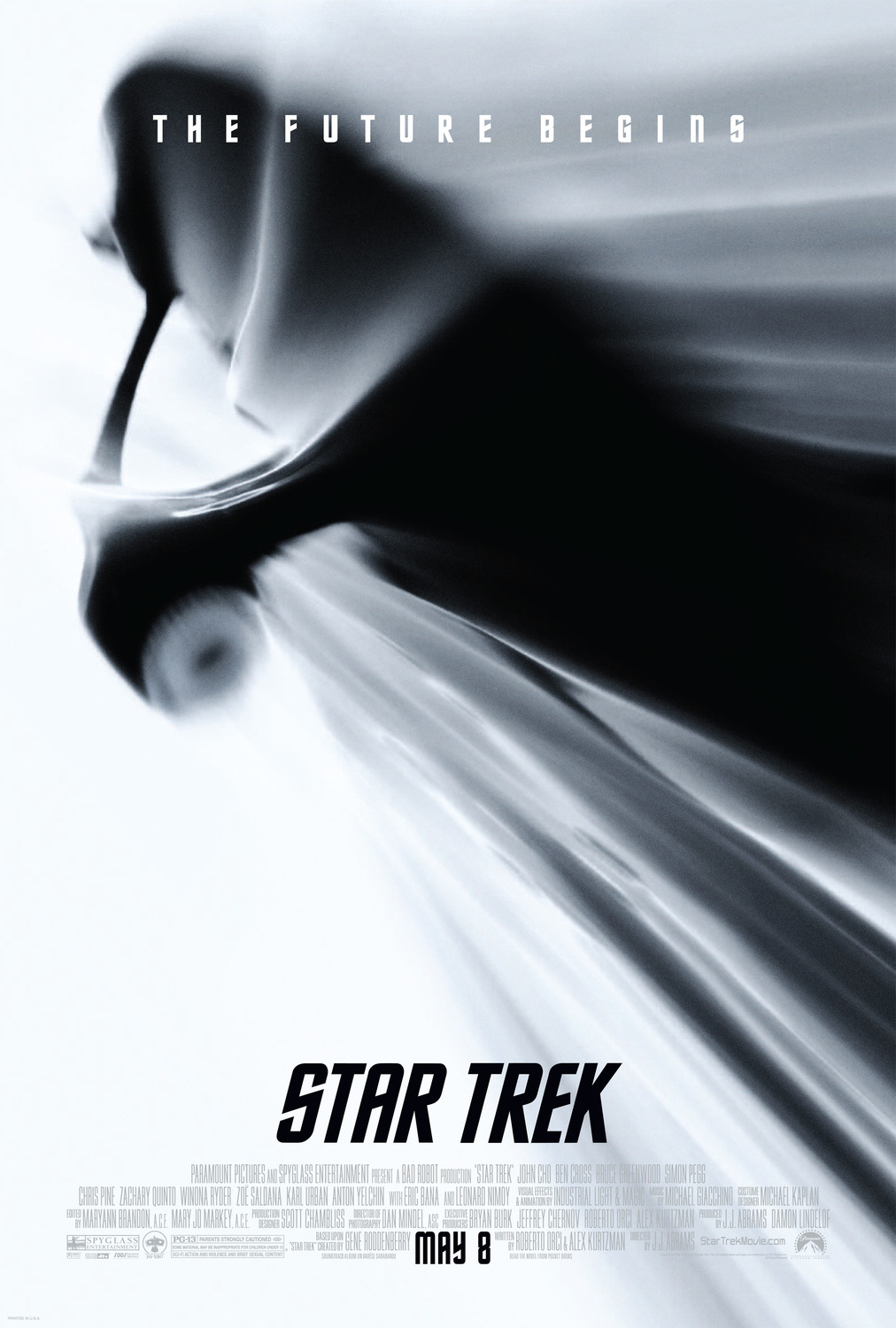
The first was the new film’s bold decision to establish an
‘alternate universe’. This concept of a ‘multi-verse’ had been previously
explored in episodes of the various Trek shows
but this was pretty much the first time that the films had ever gone this
route. As the result of a supernova being turned into a black hole, the Romulan
ship Narada ended up going back over
a century in time and its attack on the USS
Kelvin paved the way for a different
series of events that still revolved around the franchise’s classic characters,
namely James T. Kirk. A similar situation occurred last year with Terminator: Genisys and as you’d expect,
that film also got flak for going that route. However, I actually think that this
is a great idea as it allows the franchise to tell new stories within their
universes with their classic characters without having to adhere to canon. But
at the same time, another argument that people bring up about this kind of plot
development is that it results in classic moments from the series ‘being erased
from existence’… and I’ll just cut to the chase and say that this is not true.
I mean, okay, it’s true that the creation of a new timeline does do away with
beloved moments from previous films. However, it’s not like those films don’t
exist anymore. If you can still go to a place like Best Buy and are able to buy
the original Trek films without issue,
then I don’t see what the problem is with a franchise establishing a new
alternate reality. The main characters are still the same characters as before,
expect that now they are being developed in different, and technically speaking
‘more modern’, ways.

The character that benefits the most from this new timeline
is Captain James Tiberius Kirk. Of course William Shatner will always be the
original Kirk but if you ask me, Chris Pine’s Kirk is actually a much more
layered character. With Shatner’s Kirk, things usually ended up going his way
no matter how difficult the situation was. After all, as emphasized in a
classic scene in The Wrath of Khan where
he reveals that he cheated on the infamous Kobayashi Maru test, a moment which
was finally witnessed in the 2009 film, Kirk does not believe in the no-win
scenario despite being told that it a situation that every Starfleet captain
will likely face at one point. There were only a few instances where things
didn’t really go his way, with the biggest one being when Spock died at the end
of Wrath of Khan. Chris Pine’s Kirk,
on the other hand, immediately starts off on a rough path. He had to grow up with
the burden of having his father be George Kirk, who sacrificed himself to save
the lives of the crew of the USS Kelvin,
including his wife Winona and their then-newborn son [him]. So as a result, he
became a reckless and arrogant delinquent until he was approached by
Christopher Pike to enlist in Starfleet, ‘daring him to do better’ than his
dad. I feel that this helped make Pine’s Kirk a very relatable protagonist,
someone who has a lot of pressure on him to succeed. As a result, it’s cool to
see how he matures as a leader over the course of these films. Plus, this idea
of Kirk being under his father’s shadow seems to once again be relevant in the
upcoming Star Trek Beyond as the
second trailer opens with Kirk recounting how ‘he joined Starfleet on a dare’
and Bones remarking that now Kirk is trying to figure out who he really is.

As for Kirk’s eventual first officer Spock, the film further
explores the character’s half-human, half-Vulcan heritage. Right out of the
gate, he is shown to be ostracized by his Vulcan peers solely due to his father
Sarek being a ‘traitor’ for marrying ‘that human whore’ Amanda Grayson. This
prejudice is later seen when the heads of the Vulcan Science Academy remark
about how successful Spock has been despite the ‘disadvantage’ of having a
human mother. This effectively leads him to reject the invitation to the
Academy and instead enlist in Starfleet. And while Trek fans of course know that Kirk and Spock are always portrayed
as friends, the 2009 film actually doesn’t start out that way. When Kirk pulls
his little ‘stunt’ during his Kobayashi Maru test, he is immediately accused of
cheating by Spock and the two end up in a major moral conflict for most of the
film, with Spock maintaining a generally cold and logical persona throughout.
His emotions aren’t fully brought out until Kirk provokes him by questioning
why he doesn’t show any emotion over the recent death of his mother, resulting
in him lashing out at Kirk and subsequently relinquishing command to him on
account of being emotionally compromised. This is then followed by Sarek
finally admitting to him that he didn’t marry his mother because it was
‘logical’ but because he truly loved her. As a result, Spock is able to gain
better control of his emotions, allowing for him and Kirk to finally set aside
their differences and work together to stop the Narada from destroying Earth. Later, he is convinced to stay with
Starfleet and be Kirk’s first officer, being told to ‘put aside logic’ and ‘do
what feels right’. By whom, you may ask? Why, by his older self, of course!
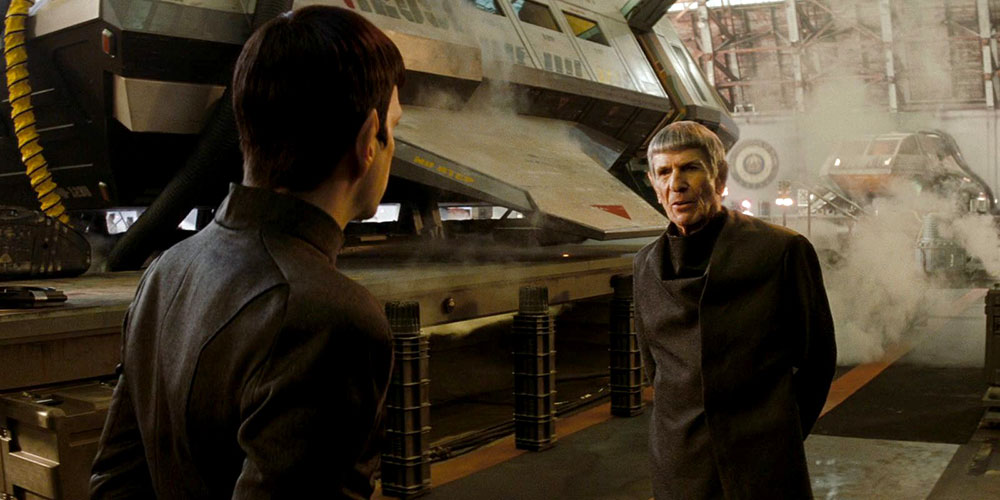
Yes, the 2009 film pulled a major coup by having Leonard
Nimoy cameo as an older Spock. His Spock is shown to be the one from the
original timeline and was partially responsible for the establishment of the
new timeline. When his attempt to save the planet Romulus from a supernova
failed, it led to the creation of the aforementioned black hole and he and the Narada were sent many years back in
time. When Kirk is marooned on the ice planet Delta Vega by the younger Spock,
‘Spock Prime’ (his credited designation in these films) helps him get back onto
the Enterprise though he doesn’t come
along to help Kirk take command of the ship, claiming that he cannot come into
contact with his younger self. However, the two Spocks do end up meeting at the
end of the film and the older Spock admits that he ‘lied’, or as he puts it,
‘implied’ about the whole time paradox thing. This is easily one of the best
cameos in recent memory, though I use the term ‘cameo’ loosely because Nimoy’s
Spock actually has a major role in the film. Nimoy is just as excellent as he’s
always been in the role. At the time, it had been a long while since he last
played the part but he slips back into the role with ease and gives the film
plenty of emotional gravitas. Now I am aware that there were also plans to have
William Shatner do a cameo but that ultimately didn’t happen. And to be honest,
I think it’s actually a good thing because I feel that having both Shatner and
Nimoy appear might have been a detriment to Chris Pine and Zachary Quinto as
the younger Kirk and Spock. By just having Nimoy appear, it allows for Pine and
Quinto’s versions of the characters to stand on their own while still giving the
film a means of connecting the new Trek with
the old Trek. Nimoy would once again
appear, this time truly in cameo form, in the sequel when the younger Spock contacts him requesting information about that
film’s main villain (more on that character later). Sadly, this would be the
last time that Nimoy ever played the part as he passed away in February of
2015.

While Kirk and Spock are obviously the main protagonists,
the film also does a great job in setting up all of the other main characters.
Not all of them get as much to do as the lead duo but they at least have one
scene each that establishes their importance to the crew. While Dr. Leonard
‘Bones’ McCoy has perennially been the third most important character of the
series, the film actually promotes Lt. Nyota Uhura to that position. And sure,
a sizable part of her role in the newer films does revolve around her romantic
relationship with Spock but I actually don’t mind that as I feel that this relationship
gives Spock a valuable human connection. Plus, I also liked how, early on,
Uhura didn’t really get along with Kirk as a result of his generally brash
demeanor. But of course the film doesn’t forget about the Enterprise’s reliable doctor, Bones, and of the entire cast, Karl
Urban probably acts the closest to his predecessor, DeForest Kelley. Urban
absolutely nails the character’s generally grumpy but still very much humane attitude,
especially in scenes where he’s arguing with Spock (“Are you out of your Vulcan
mind?”). Helmsman Hikaru Sulu (John Cho) gets to be part of a major action
sequence when he and Kirk space-jump onto a Romulan drill, which harkens back
to a famous moment from the episode ‘The Naked Time’ in which Sulu, while under
the influence of a mysterious substance, brandishes a fencing foil (from the
2009 film: Kirk: “So what kind of combat training do you have?” Sulu:
“Fencing.”). The sequel even hints at a potential future as a starship captain,
something that did happen in the original timeline, when he becomes acting
captain and threatens ‘John Harrison’ with the load of torpedoes at the Enterprise’s disposal (Bones: “Mr. Sulu… remind me never to
piss you off.”).
As for ensign Pavel Chekov (played by the late Anton
Yelchin, who tragically passed away recently meaning that the upcoming Beyond will serve as his final turn in
the role), the film immediately sets him up as a young mathematical prodigy.
Said talent comes in handy later on, especially in a scene in which he is able
to beam up Kirk and Sulu when they fall off of the Narada’s drilling device. However arguably his best moment came in Into Darkness, during which he’s promoted
to the role of Chief Engineer when Scotty decides to resign. Simply put, the
look on his face when Kirk tells him to go put on a red shirt is priceless,
showing that he clearly knows what happens to most redshirts in Star Trek. Thankfully that fate doesn’t
end up happening to him. And of course we can’t forget about the Enterprise’s trusty engineer, Montgomery
Scott, who is first introduced working at an outpost on Delta Vega before Kirk
brings him onto the Enterprise as Chief Engineer. Like Urban, Simon Pegg
absolutely nails the role from the accent to the mannerisms and the films
certainly utilize Pegg’s comedic ability to great effect, from the scene in
which he awkwardly remarks how exciting it is on the Enterprise after the whole ‘Kirk emotionally compromising Spock’
scene to the scene in Into Darkness in
which he drunkenly argues with Kirk over coms while at a bar following his
resignation. In short, every member of the Enterprise
crew matters in the long run and these films do an absolutely fantastic job
in establishing a phenomenal camaraderie amongst its cast of leads.

But perhaps the biggest issue that most Trek fans have with the new films is the fact that it seemingly
focuses more on action than the layered, cerebral plots that the franchise has
perennially been known for. And while it’s true that the films definitely have
a very action-heavy style, I don’t really see how that’s entirely a ‘bad
thing’. Chris Pine was recently quoted as saying that it’s not really possible
to do ‘cerebral’ Trek anymore in
2016, saying that “it just wouldn’t work in today’s marketplace” of big
blockbusters… and you know what? He’s totally right! Like imagine if they ever
decided to do something similar to Star
Trek: The Motion Picture… that would be a colossal disaster from a
box-office perspective. It’d do about as good as a Terrence Malick film. The
other thing is that I’d argue that while the films do lean more towards being
sci-fi action films, that doesn’t mean that they don’t have strong themes and
character arcs in them. In the case of the 2009 film, there’s things like Kirk
trying to deal with being in the shadow of his father and Spock struggling to
deal with his emotions as well as dealing with his half-human/half-Vulcan
heritage. Heck, Nero (Eric Bana) is actually a pretty decent villain as far as Star Trek villains go. He has an
emotional backstory to him as he seeks vengeance against Spock (the older
Spock, specifically, though this plot of revenge is later carried over to the
younger Spock) for being unable to save his planet Romulus from destruction. So
as payback, he makes Spock witness the destruction of Vulcan… and boy is that
an emotional gut-punch of a scene, especially when Spock’s mother Amanda falls
to her death right in front of her son. Heck this whole film is full of effective
emotional moments, including the opening as Kirk’s father sacrifices himself right
as his wife gives birth. What can I say? J.J. does a great job when it comes to
scenes like this.

Speaking of the score, Michael Giacchino’s music for these
newer Trek films are two of my all-time favorite film scores. In creating said
score, Giacchino does something that David Arnold did when he did the music for
the 2006 James Bond ‘prequel/reboot’ film, Casino
Royale. And that is that he makes the smart decision to not primarily
utilize the iconic Star Trek theme created
by Alexander Courage. Instead, that piece is fittingly used during the end
credits and I must say that Giacchino’s version of the theme is quite a rousing
cover of it. But as for the rest of the film, Giacchino does an absolute
fantastic job when it comes to creating motifs that can be either really
emotional or invigoratingly thrilling during the film’s equally thrilling
action sequences. In regards to the latter, this mainly comes in the form of this
reboot series’ main motif (exemplified in this track, ‘Enterprising Young Men’).
I absolutely adore this motif and I especially love how it can be used in both emotional
scenes (e.g. ‘Warp Core Values’ from Into
Darkness) and scenes of grand spectacle (e.g. the aforementioned
‘Enterprising Young Men’, during which we see the first look at the Enterprise, and ‘Sub Prime Directive’ from the opening of Into Darkness as the Enterprise
rises out of the ocean). In the case of the former, just look at tracks
like ‘Labor of Love’, which is played when Kirk’s father sacrifices himself
while his wife gives birth, or ‘Buying the Space Farm’ from Into Darkness, when Kirk makes the same bold sacrifices that his father made and
shares one last moment with Spock.

And yeah… let’s talk about Star Trek Into Darkness. This is one that I’ve been dying to stick
up for these past few years because ever since it came out, it’s been subjected
to much scrutiny from ‘Trekkers’. So much so that at a convention in Las Vegas
that was held a few months after the film premiered, it was named the WORST
film in franchise history, with one fan apparently claiming that the JJ films
shouldn’t even recognized as Star Trek films…
and boy does all of this piss me off. First off, Into Darkness is ‘worse’ than The
Motion(less) Picture, the yawner that is Insurrection, or the actual near-franchise killer that was The Final Frontier? But the thing that
really rubs me the wrong way is the statement about the films not belonging in
the franchise. You know, the franchise that was pretty much dead and would
still be dead if it wasn’t for the J.J. films? They seriously ranked a non-Trek film, 1999’s Galaxy Quest, higher than Into
Darkness. That shouldn’t even count! UGH! So what is it about Into Darkness that Trek fans were so upset about? It was over the big bait-and-switch
pulled by the filmmakers in which it was revealed that Benedict Cumberbatch’s
villain character was in fact the legendary franchise antagonist Khan… except
in the months leading up to the film’s release, everyone kept denying that he
was Khan. And to make things more problematic, the film then proceeded to
re-imagine some notable ‘moments’ from Star
Trek II: The Wrath of Khan, namely the bold sacrifice by a main character
to save the Enterprise from being
destroyed and the vengeful screaming of Khan’s name. However, is the film as
big of a ‘rehash’ of Wrath of Khan as
Trekkers claim? The truth is… it really isn’t…

If Star Trek Into
Darkness was about Khan trying to find a terraforming device capable of
giving new life to a dead planet or destroying every living thing if used on a
planet with life, then I’d probably be more susceptible to call the film a
‘rip-off’ of Wrath of Khan but that’s
not what the film is about. Instead, it’s about Khan enacting revenge upon
Starfleet for using him and holding the rest of his people hostage. And really,
you want to know how many things the film ‘borrows’ from Wrath of Khan? Aside from having Khan being of the villain, of
course, as well as introducing the character of Carol Marcus, who gave birth to
Kirk’s son David in the original timeline, there’s really only two major
sequences from that film that are redone here; the aforementioned sacrifice and
KHANNNN! scenes. Seriously Star Trek
Nemesis was a bigger ‘rehash’ of Wrath
of Khan. I’m not joking; the final battle of Nemesis is almost note-for-note the exact same finale. Two ships
captained by a Federation captain and his greatest ‘personal’ nemesis fighting
in a part of the galaxy where they are unable to target each other to attack,
ultimately culminating in the death of probably the most popular character of
their respective casts. Now as far as the whole thing about the cast and crew
denying Khan’s identity before the film’s release, I actually don’t blame them
for trying to keep the whole thing a secret. In the digital age, it’s become
much harder for studios to prevent leaks of spoiler-heavy material. In fact, I
already knew that Cumberbatch was going to play Khan months in advance due to
someone at Entertainment Weekly making the idiotic mistake of identifying him
as Khan when they debuted a pair of magazine covers for the film, one with Kirk
and Spock, the other with Kirk and Khan.
And speaking of Khan, Benedict Cumberbatch is fantastic in
the role. He doesn’t try to be Ricardo Montalban’s version of the character and
that was certainly a smart move… otherwise the film would’ve gotten even more
flak from Trek purists. Cumberbatch
brings a ‘Hannibal Lecter’ esque vibe to his performance, which of course is
straight-up exemplified in scenes where Khan is held captive on the Enterprise.
But perhaps the most interesting part about Cumberbatch’s take on the character
is that this film’s Khan is in some ways a very sympathetic villain. When Khan
reveals his true identity to Kirk and Spock, he then proceeds to recount his
past history. His ship and crew were found adrift by Starfleet’s
Commander-in-Chief, Admiral Marcus, who subsequently took Khan’s crew hostage
in exchange for having him develop weapons and the Admiral’s new ship, the USS Vengeance. Ultimately this of course
leads to Khan enacting revenge upon Starfleet when he is led to believe that
Marcus had killed his crew. However, as we learn, he didn’t and instead had
them placed in cryogenic freeze inside 72 of the advanced torpedoes that Khan had
been developing. Marcus then proceeds to give said torpedoes to the Enterprise to use as leverage against
him. Khan immediately recognizes this when Kirk and crew confront him on Kronos
and he willingly surrenders. And boy is the scene in which Khan emotionally
recounts how he was led to believe that Marcus killed his crew yet another
emotional gut-punch of a scene, buoyed by Cumberbatch’s absolutely powerful
performance as well as the final line of his ‘monologue’; “Is there anything
you would not do for your family?”

Once again, the film does a fantastic job of portraying the
relationship between Kirk and Spock, which hits another snag at the beginning
of the film when Kirk violates the Prime Directive and lets the Enterprise be
seen by a primitive race in order to save Spock from an active volcano. And
because Spock is very much someone who goes ‘by the book’, he ends up reporting
this to Admiral Pike and Kirk is relieved of his command as a result. Obviously
Kirk is pissed and Spock’s general ‘lack of emotion’ once again proves to be an
issue for him. It even strains his relationship with Uhura as a result of him
seemingly embracing his death at her expense. The film also continues to focus
on Kirk’s reckless behavior, as Pike comments that this kind of attitude could
get everyone under his command killed. That ends up being Kirk’s arc in this
film; learning to take better responsibility for his actions. Because when
‘John Harrison’ attacks Starfleet and Pike ends up being one of the casualties,
it leads to him recklessly going after Harrison to avenge the death of the
person who become the closest thing that Kirk ever had to a father figure in
his life. And sure, while Spock is the one who is with Pike when he dies,
Kirk’s reaction to his death is still pretty damn emotional as is the scene
where Spock mind-melds with Pike before he dies. Ultimately by the end of the
film, Kirk follows in his father’s footsteps by saving his ship at the cost of
his life by entering the ship’s radioactive reactor chamber and realigning the
warp core.

And folks, I won’t lie in saying that the scene in which
Kirk and Spock share one final moment before Kirk dies from radiation poisoning
brings me to tears every time that I watch it. And yes, I know that it’s almost
exactly the same as that scene from Wrath
of Khan but aside from one or two lines of dialogue that are lifted from
the previous film (e.g. ‘ship out of danger’), the filmmakers actually do
enough to differentiate this scene from its predecessor, namely in regards to
context. In Wrath of Khan, this was
pretty much the first time that Kirk truly has to deal with a ‘no-win’
scenario. In Into Darkness, this
scene reaffirms the friendship between the two. All throughout the film Kirk tries
to prove to Spock why he risked violating the Prime Directive to save Spock
from the volcano and it is in this moment when Spock realizes why he did it; he
wasn’t going to let his best friend die. And as for the once-again infamous
‘KHAANNN!’ scene, this time performed by Spock, yeah it’s ridiculous but the
same could be said for when William Shatner did it in Wrath of Khan. With that said, some have argued that this scene is
‘pointless’ due to the fact that it wasn’t necessarily Khan’s fault for the Enterprise falling helplessly to Earth.
And yet, like the argument that the film is a complete retread of Wrath of Khan, that’s not entirely true.
Sure, most of the damage sustained to the ship was caused by the film’s other
‘villain’, Admiral Marcus, but Khan ended up taking control of Marcus’ ship,
which then proceeded to further attack the Enterprise.
So I’d argue that said further attack is what ultimately led to the ship
falling to Earth. So yes, even if it’s only in a minor way, Khan WAS partially
responsible.
And yeah… maybe I should talk about the big elephant in the
room. And that is in regards to the film’s major McGuffin, Khan’s blood. As
shown in the beginning of the film, Khan is able to blackmail a Starfleet
officer into bombing a Starfleet facility by offering to help save the officer’s
terminally ill daughter with the use of his blood. And as you might expect,
Khan’s blood is what is ultimately used to save Kirk. Bones realizes this when
a dead Tribble that he has been experimenting on suddenly comes back to life as
a result of the blood. Is it ridiculous? Yes. Is the part with the Tribble
rather blatant fan-service? Yes. Am I in any way bothered by this plot-point?
No. Because believe me, the Star Trek franchise
has seen plenty of silly plotlines over the years, like in Star Trek IV: The Voyage Home when the villain was a giant space
log that was trying to talk to humpback whales. And yes, I think it’s pretty
clear that this plotline of, to quote its critics, ‘magic blood’ probably isn’t
going to brought up again in future films, which would effectively make this
‘new discovery’ that could fix a whole lot of problems rather pointless in the
long run. But again, I’m not too bothered by that because at the end of the
day, Into Darkness is just like its
predecessor in being a very fun and action-packed adventure buoyed by effective
emotional depth and terrific character development. Worst Star Trek film of all-time this is not… not by a long shot.
Now I will admit… I’m quite biased towards the J.J.-era films.
I’ll admit that prior to 2009, I knew little about the Star Trek franchise but I was interested in seeing the 2009 film
after hearing that it got really exceptional reviews from critics. So I went to
go see it with my dad, loved it, and afterwards, I learned that he was a fan of
the series. As a result, I started to get into the series more and more. But
time and time again, I found myself coming back to the 2009 film, mainly after
I bought it on iTunes (which was pretty much the first major film ‘home media
purchase’ that I ever made) and then proceeded to watch it numerous times. So
yeah… you could say that the 2009 film is a very personal one for me and
because of that, it legitimately has become one of my Top 10 favorite films of
all-time. As a result, Into Darkness became
my most anticipated film of 2013. When I first saw the film, I gave it a 4.5/5
rating but then had to start dealing with the slowly increasing
backlash towards the newer films, mainly brought on by Into Darkness, to the point where I wondered if I was being a bit
too lenient towards it. But when I bought on Blu-Ray on the week it came out, I
re-watched it and was thrilled to see that not only did I still love it, it was
even better in my opinion the second time around. So I updated my rating to 5/5.
I’m an unapologetic fan of the J.J.-era Trek
film and feel that they are far better than what Trek purists constantly put them out to be. Sure they may appeal to
non-fans more due to their more action-focused pacing but I argue that they
still do enough to capture that Trek feel,
namely through the great characterizations of its protagonists and its strong
emotional depth.
You can bet that I’m very much excited for Star Trek Beyond, which clearly has a
lot to prove. It certainly hasn’t been easy to appease to long-time Trek fans, especially considering that
they hired another ‘action’ director, Justin Lin, to take over for J.J. Abrams,
who of course was busy working on a different Star film that you may have heard of. However, I don’t see how
that’s a ‘bad’ thing due to Lin being one of the best action directors in
recent years thanks to his work on the recent Fast and Furious films. Plus, Lin has made it clear that he is a
fan of Trek, which I guess you can
say is better than what was the case with J.J., who admitted that he was a
bigger fan of Star Wars (But I sure
as hell ain’t holding him to that, mind you). The film surely will also benefit
from having Scotty himself, Simon Pegg, handling script duties as Pegg’s sci-fi
fandom background as well as his work on the Cornetto trilogy will no doubt
provide the film a solid pedigree. However, when the film’s first trailer was
released, the ‘too much action’ argument was brought up once again, with Pegg
admitting that even he wasn’t a fan of how the action-oriented trailer was put
together. Me personally, though, I thought the trailer was perfectly fine. I
also didn’t really get the complaint about the use of ‘Sabotage’ by the Beastie
Boys being out of place considering that this was part of a major sequence in
the first film. However, thankfully the second trailer was received much more
positively and based on all of the clips that I’ve seen from it, many of which
once again showcase the amazing camaraderie amongst the new cast members, I’m
confident that Star Trek Beyond will
be yet another super fun sci-fi adventure. However, I’m also hoping that this
one will fare better with Trek purists
because, well, I’m getting sick of having to defend these newer films against
them.
And that marks the
end of my very, very long defense of J.J. Abrams’ Star Trek films. Anyone else share my thoughts towards the newer
films? And if so, are you excited for Star
Trek Beyond regardless of how long-time Trek
fans might respond to it? Be sure to sound off in the comments below.
Next time: My review
of Star Trek Beyond

